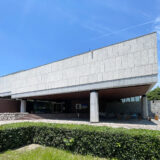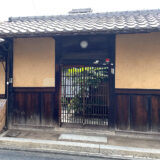Kyoto is now at the height of the fall foliage season, and many tourists from inside and outside the country are visiting.
One of the most popular attractions among these tourists is the special nighttime viewing and lighting of shrines and temples.
Among them, I went for a night walk to see the illumination of Kiyomizu-Dera Temple, which attracts many visitors every time I visit.
On the way to Kiyomizu-Dera Temple on foot from my house, I passed by the Minami-za Theater1, the birthplace of Kabuki. I came across a Maneki-age in preparation for the Kabuki “Kichirei-Kaomise”2 performance that will begin on December 1.
A Maneki is a signboard in front of a theater that lists the names of the actors who will appear during a performance.
This Maneki-age is also one of Kyoto’s most popular winter scenic features.
The celebratory stage curtain for this year’s show is based on an original drawing created by artist Takashi Murakami.
Incidentally, Takashi Murakami will hold a significant exhibition in Kyoto next February.
I will cover this topic another time in this blog.
Further along the walk, the five-story pagoda of Hokanji Temple1 came into view. It is commonly known as “Yasaka-no-to” (Yasaka Pagoda).

Further up the hill, the illuminated Niomon Gate, Nishimon Gate, and the three-story pagoda of Kiyomizu-Dera Temple came into view.
The area around the famous “stage” of the main hall was so crowded that we could hardly move.

Although it was very crowded, the autumn foliage was at its peak, and the illumination combined with the Kiyomizu-Dera Temple buildings created a fantastic atmosphere, making it an enjoyable evening stroll.







Footnotes
- Minami-za Theater – KABUKI Official Website ↩︎
- Kabuki’s Kaomise Performance is a traditional kabuki event held annually at the Minamiza Theater in Kyoto, Japan.
The event, held annually in December, celebrates the opening of a new theatrical year by unveiling new actors and performances.
The Kichirei-Kaomise Performance began in the Edo period (1603-1867) and is an essential event in the history and culture of Kabuki, which continues today. Traditional costumes, spectacular stage sets, and unique acting styles leave a deep impression on the audience. It is popular among tourists as an excellent opportunity to experience traditional Japanese performing arts. ↩︎ - Hokanji Temple – KYOTO CITY OFFICIAL TRAVEL GUIDE ↩︎




